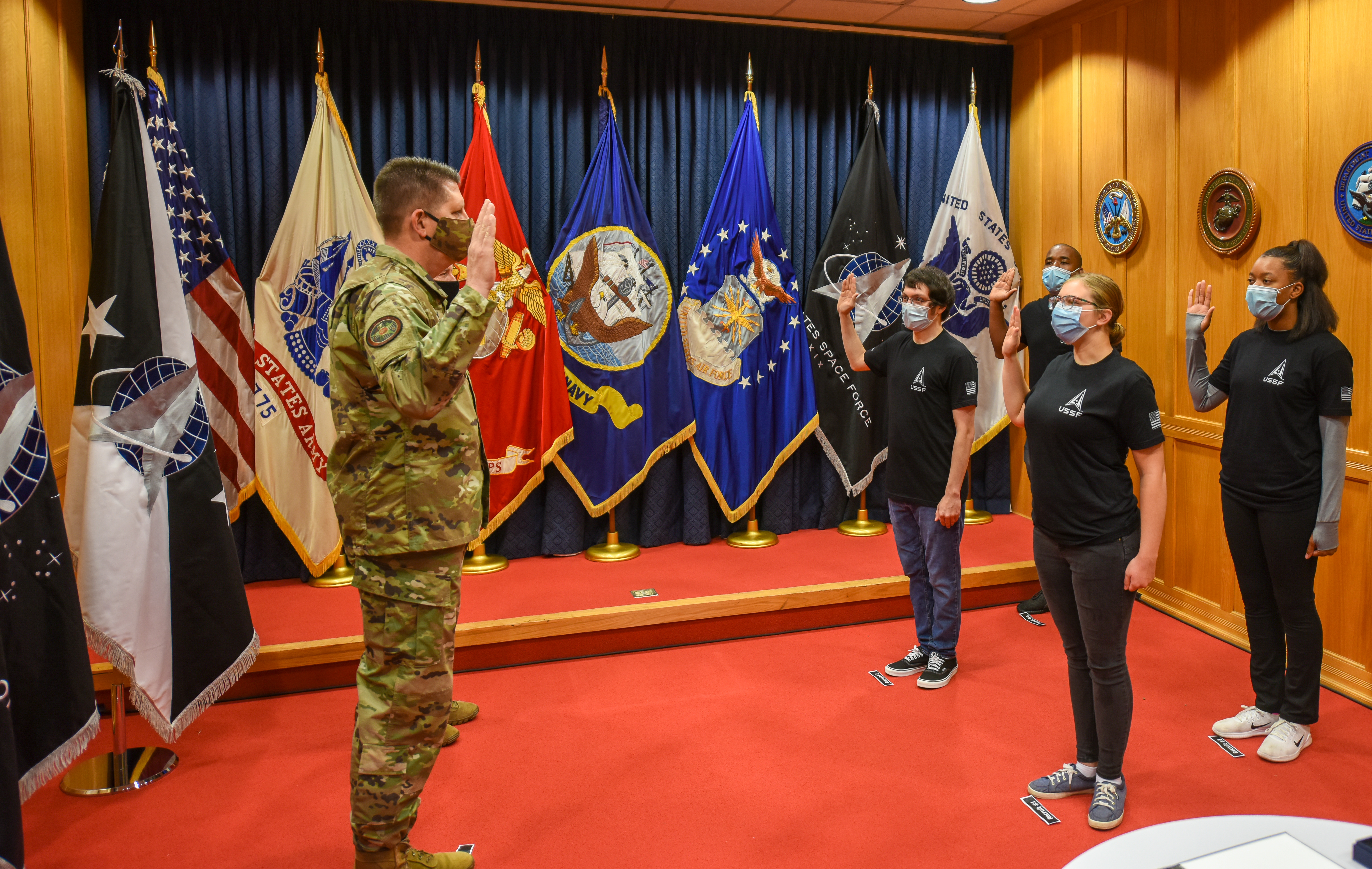Space Force processing has launched!
By Scott Koker
Messenger Associate Editor

The Vice Chief of Space Operations Gen. David D. “DT” Thompson swore in the first four Space Force recruits at the Baltimore Military Entrance Processing Station, Fort George Meade, Md., October 20, 2020. The first four recruits will join three others from Colorado, placing them on a direct path to Basic Military Training and marking another milestone in the new service’s growth and development. (U.S. Space Force photo by Tech. Sgt. Armando Schwier-Morales)
For the first time in 73 years, a new U.S. military branch will begin processing applicants.
The U.S. Space Force will welcome its first four enlistments at the Baltimore Military Entrance Processing Station and three at the Denver MEPS.
“I’m really proud of the work the Baltimore and Denver MEPS teams have done to prepare for this event,” said Col. Richard Brady, USMEPCOM commander. “They understand the historical significance of it and they’re doing everything they can to make sure they roll out the red carpet and show what USMEPCOM provides to the nation through these enlistments.”
The presiding officers for the Oath of Enlistment ceremonies will be Gen. David D. “DT” Thompson at Baltimore MEPS, and Maj. Gen. Stephen N. Whiting at Denver MEPS. Thompson is the Vice Chief of Space Operations and Whiting is the deputy commander, Headquarters, United States Space Force.
“We routinely get VIP visits at USMEPCOM, but to have VIP visits coupled with a historic event like this is very unique,” Brady said.
Director of Military Accession Policy, Stephanie Miller will be part of the Baltimore ceremony while Brady will attend the Denver event.
“Personally, it’s definitely an honor to be part of this historic moment,” Brady said. “From an organization perspective, it also reflects the uniqueness of our mission here at USMEPCOM and what we do. We’re the only organization that has the mission of qualifying effective, able-bodied personnel in the Army, Navy, Air Force, Marine Corps, Coast Guard and Space Force.
“It’s a big moment for the organization and I’m really looking forward to being part of this event.”
The seven new enlistees will join more than 2,400 Air Force personnel selected to transfer to Space Force.
“The numbers will start out relatively small,” Brady said of new enlistments. “We expect they will grow over time. As the Space Force gains in capability and capacity, they will establish larger numbers of projections coming into the MEPS for accessions.”
The last time a new military branch processed its first applicants occurred shortly after the National Security Act of 1947 created the Department of the Air Force.
“I’m looking forward to meeting the three (new Space Force enlistees) in Denver and getting a sense if they have a real sense of the historical significance of this event and their role in it because their pictures and stories will live on forever in Space Force history,” Brady said. “They’re unique and very fortunate to be part of this day as well.”
Space Force was formed in December as part of the National Defense Authorization Act. President Donald Trump appointed Gen. John W. “Jay” Raymond as chief of space operations. Chief Master Sgt. Roger A. Towberman was named senior enlisted advisor.
“I think it makes sense,” Brady said of Space Force. “Space as a warfighting domain is gaining in significance and importance. From a military and a geopolitical standpoint, it makes sense to have a dedicated force that’s looking after that warfighting domain.”
Space Force turned to Air Force Recruiting Services to fill more than 300 enlisted positions next year.
“We’ve gotten away from a checklist-driven mindset to where we are lean and agile and our young airmen have to think on the fly sometimes to outmaneuver some of our adversaries,” Senior Master Sgt. Randy Magdaleno, manager of Space Force Special Programs Division, said of the recruiting strategy. “As an example, we have young airmen sitting in the 2nd Operations Squadron flying the GPS satellites and what a lot of people don’t know is our Air Force and, now our U.S. Space Force, do the satellite command and control and operate our GPS systems out there for the world.”
As for processing, Brady said Space Force’s medical testing is no different from the other military branches.
“The biggest hurdle for USMPECOM was on the system side of processing,” he said. “A lot of what we’ve been doing to prepare for Space Force is more on the tactical level, including working on the processes we’d use to enlist them in and making sure the coding in our system is right and paperwork is correct.
“We’re rewriting some of the system software to account for a new service.”
Most of the Space Force jobs will “focus on orbital warfare, space electronic warfare or space battle management,” said Senior Master Sgt. Daniel Hill, Space Force manager for the 1C6 Space Systems Operators Air Force Specialty Code. “We fly satellites, keeping them in position or repositioning them if a threat is detected. We use radar to detect missile launches and track space debris to protect our assets in space.”
According to the Space Force website, the branch’s mission is to organize, train and equip forces “in order to protect U.S. and allied interests in space and to provide space capabilities to the joint force.”
The Space Force’s responsibilities “include developing military space professionals, acquiring military space systems, maturing the military doctrine for space and organizing space forces to present to our Combatant Commands.”
Space Force locations include Buckley Air Force Base in Aurora, Colorado; Los Angeles; Patrick Air Force Base in Brevard County, Florida; Peterson Air Force Base and Schriever Air Force Base in Colorado Springs, Colorado; and Vandenberg Air Force Base near Lompoc, California.